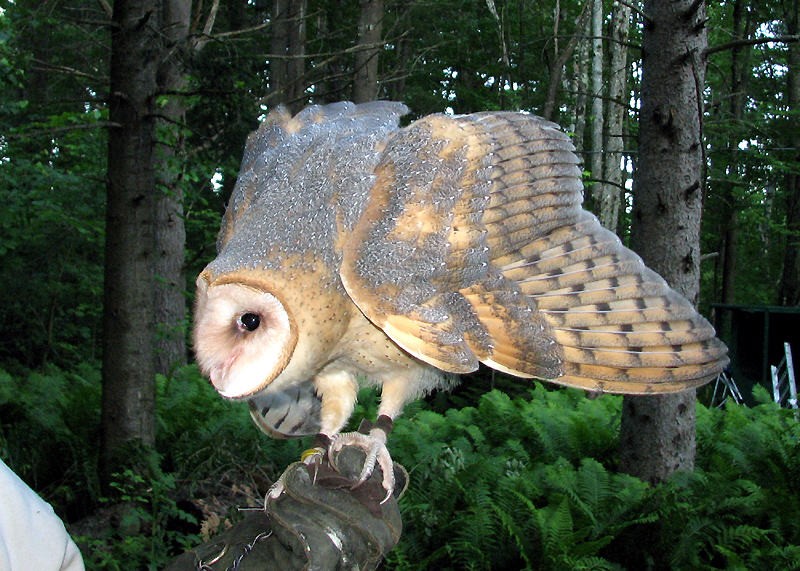How do you describe Barn Owls? To begin
with, what birds are
stranger than owls? The oddly inelegant shape, the seemingly humorless
and
serious demeanor, the hostile and insistent beak snapping, the strength
all out
of proportion to their sizes? And then there is the barn owl, with that
heart
shaped, almost alien, face, the head wagging when surprised or
threatened, the
long, gawky legs, and that arrestingly loud, drawn out and raspy hiss,
like a
cobra with a microphone. Barn owls are a weird and fascinating species,
even
within the ghostliest of raptor orders, Strigiformes. The Martians
have
landed, and they have come for your rodents! In an interesting
observation,
the Carolina
Raptor
Center, speculating on the origin of ghosts and goblins in people's
minds,
and mindful of the link between old barns, church steeples and
agricultural
fields, in other words, the proximity of villages to barn owl nesting
sites,
wonder whether the ghostly appearance, odd hisses, screeches and
screams of the
barn owl, helped foster such nightmares.
Barn owls are the most widely distributed of all raptors, found on
every
continent but Antarctica. Alas, barn owls, and other members of the
family
Tytonidae, seem more delicate than members of the "true owl" family,
Strigidae, with most dying during their first year, and with the
average age in
the wild of only 18 months. Wesley, the hero of Stacey O'Brien's book
about her
barn owl, lived to be 20, so once again, when you add a steady food
supply, observation,
and care to a wild animal, it dramatically increases their life span.
Mature
barn owls are just under a pound, and about 15 to 20 inches from beak
to tail.
As with all raptors, the females are larger than the males, and have a
slightly
more reddish golden-brown breast than the males, with more prominent
spots.
Barn owls have wing spans from 36 to 48 inches. Great Horned Owls take
a
discouragingly high proportion of barn owls and are sometimes suspected
of
patiently perching near barn owl nest sites to grab branchers and
fledglings.
Other mortality factors are what you'd expect: vehicles, pesticide
poisoning,
being shot, high power lines, etc.
Barn owls are rodent-eating machines, and, as many farmers are
rediscovering,
safer and more effective than rodenticides, as they kill only the
targeted
animals. A mating pair of barn owls raising five owlets, may take 3,000
rodents
in a year, and since barn owls seem to breed in response to the rodent
supply,
they may breed multiple times in any given year. In addition, barn owls
are
less territorial than other raptors, so, as Tom Hoffman points out at Barn Owl Headquarters,
the
farmer may have set up six barn owl nesting boxes within a 100 acre
field.
While most of what barn owls take are small rodents, according to BarnOwlBox,
barn
owls have displayed a versatility in hunting various types of prey,
focusing on
pocket gophers in California wine country, bats in Austria, red wing
blackbirds
in parts of the Midwest, house mice in Spain, and have even been seen
catching
fish. Is anything safe?!
As with the Great Horned Owl, a consideration of the barn owl's
offensive
weapons, along with their tools for detecting prey, lead to the
conclusion that
life is definitely not fair for the rodents they prey on. The
barn owl
seeks his prey, by flying in a side-to-side pattern, about ten feet off
the
ground, with the legs swaying left and right, while sweeping a narrow
swath of
ground. Sometimes they will hunt from a perch, gliding down to seize
rodents.
As with other owls, the barn owl's eyes are locked into the skull
sockets in
such a way, that the owl must swivel the head to change its field of
vision.
Like people, owls have binocular vision, while other raptors' eyes are
located
on either side of the face. A barn owl's eyes are twice as efficient as
ours in
dim light and are better at discerning outlines. Like a boxer slipping
punches,
barn owls bob their head when reacting to movement in their immediate
vicinity.
Some say this is done to improve depth perception.
A barn owl's hearing is anywhere from 25 to 100 times more sensitive
than ours.
The ears are asymmetrical, with one set high on the right, and the
other in an
inverted position low on the left just inside and under the
heart-shaped facial
disk, whose outline is formed by stiff, bristly tan feathers, and which
acts as
a dish for collecting sound. When sound reaches the lower ear, the barn
owl
swivels the head through it's lateral and medial axis, until the sound
is
hitting both ears simultaneously, and, because the eyes can only look
straight
forward, by definition, the owl is staring at the location of the
sound's
source. Laboratory tests indicate that blindfolded barn owls can catch
mice,
using their hearing alone, and can not only locate a mouse by the sound
of its
heartbeat, but can audibly discern the movements of one type of prey
from
another.
Soft and light feathers enable silent flight, by breaking the air
disturbance
of the wings, into thousands of tiny pockets of turbulence, inaudible
to the
ears of mammals. This not only prevents the prey from hearing the owl's
approach
but allows the owl to continue triangulating the prey's location as
they approach.
The outer toe swings back and forth, to enable perching with three toes
in
front, and the rear toe, or hallux, in the rear, or, when striking
prey, to
swing back and join the hallux, in framing the rodent's spine, leading
to a
firm grip, allowing an easier kill by the beak. As the owl reaches its
unsuspecting prey, the legs extend the open talons forward, the head
draws back
and the eyes shut, as the talons grasp the prey. If the prey is not
killed by
the crush of the talons, the beak is used to quickly finish the job.
Female barn owls can brood when they're a year old. Like most owls,
barn owls
do not construct nests, but appropriate any suitable cavity, natural or
man
made, where the female lays 3 to 12 eggs, in intervals of 2 to 3
days.
Incubation lasts about 33 days for each egg, and the owlets fledge at
between
56 and 62 days. Mom broods while Dad hunts and provides food for Mom
and the
growing owlets.
It is not unusual during the nesting season, to find owlets on the
ground in
the vicinity of the nest. Before "rescuing" this comically hostile
ball of feathers, observe the owl over a few days, just to confirm that
the
parents are not feeding it where it sits. If the vertical "keel" of a
bird's breastbone feels sharp, and protrudes out from the attached
muscles,
it's often a sign of starvation, in which case it means the young owl
is not
being fed, and it's time to call the rehabber. The young owl may be a
brancher
who tumbled from its perch in its first attempt at flight, or was
booted by an
older unsentimental sibling, as a strategy for garnering a higher
portion of
the food Mom and Dad bring back to the nest. Each Summer, some of our
education
birds, notably the Great Horned and Barred owls, foster-parent
fledglings, who
are later released in early Fall.














